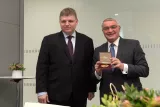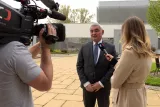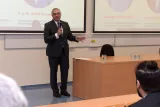Published: 24.05.2022
The University of Pardubice has been visited by the Armenian Ambassador to the Czech Republic Ashot Hovakimian. The reason for his visit was a unique project of research and documentation of archaeological sites in the eastern part of Armenia, which is being implemented by the experts of the Faculty of Arts and Philosophy of the University of Pardubice. During his programme on Tuesday, the ambassador met with the rector of our university, Libor Čapek, and also had a discussion with students.
"I am very happy that we can welcome the Ambassador of Armenia to the University of Pardubice and I am proud that it is also thanks to the great project of our experts and students. Their work in Armenia brings impressive results that have an international scientific overlap," said the Rector of the University of Pardubice, Prof. Libor Čapek, before the visit.
Last year, students and experts from the Faculty of Arts and Philosophy researched and documented archaeological sites and architectural monuments in the Eastern Armenian province of Vayots Dzor. One particular result of their work within the Hayastan project is, for example, a unique digital model of a cave or a reconstruction of the face of one of its former inhabitants.
"We conducted a survey of the Areni-1 cave, which is famous for its 6,000-year-old evidence of wine processing, copper work and remarkable finds of objects made of organic matter. During the next stage of our work, which is the documentation of monuments and the natural environment in 3D, a digital model of the cave and an overall idea of the valley in which it is located was created," said project leader Jan Frolík, PhDr., CSc. of the Institute of Historical Sciences at the Faculty of Arts and Philosophy, University of Pardubice.
Work on two archaeological sites will continue this year. The students are involved in geophysical surveys of ten archaeological, mostly prehistoric, sites selected by archaeologists from the Institute of Archaeology and Ethnography of the National Academy of Sciences of the Republic of Armenia in Yerevan, which is a partner organisation. Hayastan builds on the previous successful Apostolus project (2016-2019).









